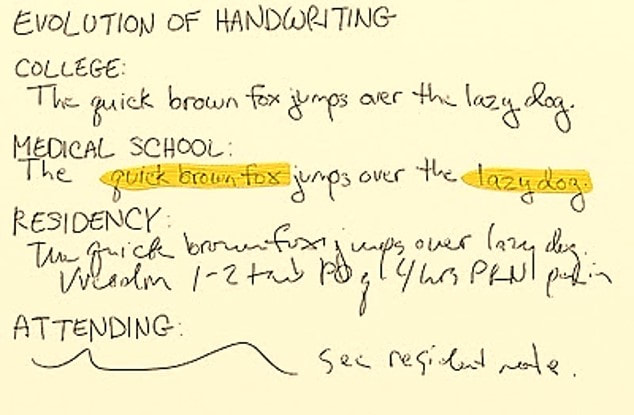|
This was triggered by my recent visit, not to any doctor, but to the friendly, neighborhood laundry guy. He was scribbling a receipt for the clothes I had just given him when another customer, watching him write, remarked, “You should have been a doctor!” “Just need to get the degree,” the laundry man responded with a smile, “my handwriting has already qualified.” The joke continued when I crossed the road to get to the pharmacy. The pharmacist was deep in conversation with an elderly customer. They were both looking at a slip of paper that, going by the scrawl-style, might have been a written by the laundry man. I waited patiently as the conversation went over symptoms, likely diagnosis, the expected effect of the prescribed medicines and potential side effects. After sending the patient away (“when do you want me to come back?”), the pharmacist turned to me apologetically. “I don’t think he would have been able to read it even if he wanted to. Took me years after pharmacy college to read what doctors write. Of course, can’t expect every doctor to spend time explaining everything to every patient.” Grave consequencesThis joke is anything but new. But why has it persisted over decades? Why are doctors associated with bad handwriting? Not that it can be brushed off as a joke when “bad handwriting by doctors is responsible for 7,000 deaths every year” as cited by this old article. Worse, illegible handwriting is a major cause of “medication error,” that kills 30,000 people in the UK and 100,000 in the US, every year. Back in 2015, neurologist Dr Nomal Chandra Borah, founder of GNRC, observed that he was unable to decipher 25% of the prescriptions written by other doctors. He cited a case where a woman suffering from convulsions was admitted to his hospital. Another doctor “had prescribed her DUODIL—an analgesic, but what was bought and consumed was DAONIL—a medicine for diabetics. This was causing a sudden fall in her blood sugar levels, leading to the convulsions. Such a grave consequence, simply because of the illegible handwriting of the doctor….” Dr Borah applauded the guidelines from the Medical Council of India (MCI) asking doctors to write complete and detailed prescriptions “legibly and in capital letters.” However, he noted that it was hardly practiced and there was “no monitoring mechanism to ensure adherence.” (By the way, the MCI was dissolved on September 25, 2020, and replaced by the National Medical Commission.) What the doctors saidI decided to go to the source of the prescription and ask a few doctor-friends. Here are some bits from the responses. “Doctors are terribly busy. Would rather move to the next patient quickly than spend time to write neat and clean.” “People often doubt if I am really a doctor. Because anyone can read my prescriptions easily.” “It starts from the training days. You are supposed to go on rounds with the seniors and note the details of every patient. There is so much repetitive writing to do and very little time. You know the nurses would understand in any case. So, you just scribble to comply. And the habit sticks.” “When you are in college, there is a premium on neat handwriting. Your examiner is not your patient. Then workload and good old boredom take over. At least some seniors I know take the scribble as a strange status symbol. After all, it is to be read by another doctor who deals with another part of anatomy. Or a chemist. It is not meant to be read by the patient, they say.” “I knew a fellow doctor whose prescriptions could be deciphered only by a specific chemist. Not sure if he used some code.” “Technology is making a difference. Hospitals are getting paperless. Prescriptions are printed. Patient records are digital. You are complaining of bad handwriting still? Wait until AI gets here.” Some palliative medicine specialists I spoke to thought bad handwriting was a non-issue. “Every patient needs an understanding ear and a caring touch. Prescriptions come later.” Of course, I didn’t have the heart to tell them that the hero prescription now is AI and not EI (empathetic intelligence). Just Google itTalking of AI, surely bad handwriting ought to be something it can tackle easily? Apparently, it is! In December 2022, Google announced it was working on “an artificial intelligence (AI) and machine learning (ML) model that can identify and highlight medicines within difficult-to-read handwritten prescriptions.” Looks like we will soon have an app that can read any doctor and tell you what the doctor wants you to take to get better. Just what the doctor ordered! Or is it? Meanwhile, the doctor joke continues to bounce clean off the laundry guy. And the chemist offers human intelligence, experiential learning, and a patient ear to tell you what the prescription reveals. And no clinical touch needed; you can use your mobile wallet to pay for the medicine you hope will make you, well, well. Image: http://doccartoon.blogspot.com/2010/02/blog-post_07.html
2 Comments
Rutuja Patil
23/4/2023 09:41:39 am
Such I interesting read for a very common problem. I really believe that human behaviour (here dr handwriting) are developed by certain circumstances and unless those circumstances are addressed no change is going to happen with the issue. I agree with one of your responses which mentions use of tech to overcome this issue like any other issue now a days.. electronic medical records is the future.
Reply
Leave a Reply. |
AuthorVijayakumar Kotteri Categories
All
Archives
July 2024
|


 RSS Feed
RSS Feed

